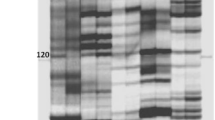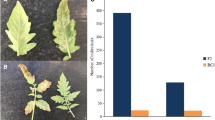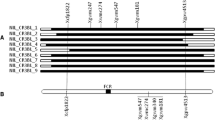Abstract
Four different populations segregating for one of the two closely linked (possibly allelic) tomato disease resistance genes to the fungusCladosporium fulvum,Cf-4 andCf-9, were generated and analysed for recombination frequencies between theCf-genes and restriction fragment length polymorphism (RFLP) loci. The population consisting of F2 progeny from the interspecific crossLycopersicon esculentum carryingCf-9 ×L. pennellii was identified as the most useful for RFLP mapping of theCf-4/9 locus and an RFLP map around this locus was constructed mainly using this population. The two closest markers identified were CP46, 2.6 cM distal, and a group of 11 markers including TG236, 3.7 cM proximal toCf-4/9. A polymerase chain reaction (PCR)-based procedure for the rapid identification of recombination events between these two markers was developed. The regions of foreign DNA introgression surroundingCf-4 andCf-9 in near-isogenic lines were delimited.
Similar content being viewed by others
References
Arondel V, Lemieux B, Hwang I, Gibson S, Goodman HM, Somerville CR (1992) Map-based cloning of a gene controlling omega-3 fatty acid desaturation inArabidopsis. Science 258:1353–1355
Balint-Kurti PJ, Jones DA, Jones JDG (1994) Integration of the classical and RFLP linkage maps of the short arm of tomato chromosome I. Theor Appl Genet (in press)
Bernatzky R, Tanksley SD (1986) Methods for the detection of single or low copy sequences in tomato on Southern blots. Plant Mol Biol Rep 4:37–41
Beek JG van der, Verkerk R, Zabel P, Lindhout P (1992) Mapping strategy for resistance genes in tomato based on RFLPs between cultivars:Cf9 (resistance toCladosporium fulvum) on chromosome 1. Theor Appl Genet 84:106–112
Chetelat RT, De Verna JW (1991) Expression of unilateral incompatibility in pollen ofLycopersicon pennellii is determined by major loci on chromosomes 1, 6 and 10. Theor Appl Genet 82:704–712
Church GM, Gilbert W (1984) Genomic sequencing. Proc Natl Acad Sci USA 81:1991–1995
De Wit PJGM, Spikman G (1982) Evidence for the occurrence of race and cultivar-specific elicitors of necrosis in intercellular fluids of compatible interactions ofCladosporium fulvum and tomato. Physiol Plant Pathol 21:1–11
Dickinson MJ, Jones DA, Jones JDG (1993) Close linkage between theCf-2/Cf-5 andMi resistance loci in tomato. Mol Plant-Microbe Interact 6:341–347
Fisher RA, Yates F (1963) Statistical tables for biological medical and agricultural research, Oliver and Boyd, Edinburgh
Gebhardt C, Ritter E, Barone A, Deberner T, Walkemeier B, Schachtschabel U, Kaufmann H, Thompson RD, Bonierbale MW, Tanksley SD, Salamini F (1991) RFLP maps of potato and their alignment with the homoeologous tomato genome. Theor Appl Genet 83:49–57
Giraudat J, Hauge BM, Valon C, Smalle J, Parcy F, Goodman HM (1992) Isolation of theArabidopsis ABI3 gene by positional cloning. Plant Cell 4:1251–1261
Gorg R, Hollricher K, Schulze-Lefert P (1993) Functional analysis and RFLP-mediated mapping of theMlg resistance locus in barley. Plant J 3:857–866
Hammond-Kosack KE, Jones JDG (1994) Incomplete dominance of tomatoCf-genes for resistance toCladosporium fulvum. Mol Plant-Microbe Interact 7:58–70
Jones DA, Dickinson MJ, Balint-Kurti PJ, Dixon MS, Jones JDG (1993) Two complex resistance loci revealed in tomato by classical and RFLP mapping of theCf-2,Cf-4,Cf-5 andCf-9 genes for resistance toCladosporium fulvum. Mol Plant-Microbe Interact 6:348–357
Joosten MHAJ, Cozijnsen TJ, De Wit PJGM (1994) Host resistance to a fungal tomato pathogen lost by a single base-pair change in an avirulence gene. Nature 367:384–386
Kan JAL van, Van Den Ackerveken GFJM, De Wit PJGM (1991) Cloning and characterization of cDNA of avirulence geneavr9 of the fungal pathogenCladosporium fulvum, causal agent of tomato leaf mold. Mol Plant-Microbe Interact 4:52–59
Kerr EA, Bailey DL (1964) Resistance toCladosporium fulvum Cke obtained from wild species of tomato. Can J Bot 42:1541–1554
Kinzer SM, Schwager SJ, Mutschler MA (1990) Mapping of ripening-related or -specific cDNA clones ot tomato (Lycopersicon esculentum). Theor Appl Genet 79:489–496
Klimyuk VI, Carroll BJ, Thomas CM, Jones JDG (1993) Rapid preparation of plant tissue for reliable PCR analysis. Plant J 3:493–494
Konieczny A, Ausubel FM (1993) A procedure for mappingArabidopsis mutations using co-dominant ecotype-specific PCR-based markers. Plant J 4:403–410
Martin GB, Brommonschenkel SH, Chunwongse J, Frary A, Ganal MW, Spivey R, Wu T, Earle ED, Tanksley SD (1993) Map-based cloning of a protein kinase gene conferring disease resistance in tomato. Science 262:1432–1436
Martin GB, de Vicente MC, Tanksley SD (1993) High-resolution linkage analysis and physical characterization of thePto bacterial resistance locus in tomato. Mol Plant-Microbe Interact 6:26–34
Messeguer R, Ganal M, de Vicente MC, Young ND, Bolkan H, Tank-sley SD (1991) High-resolution RFLP map around the root-knot nematode resistance gene (Mi) in tomato. Theor Appl Genet 82:529–536
Miller JC, Tanksley SD (1990) RFLP analysis of phylogenetic relationships and genetic variation in the genusLycopersicon. Theor Appl Genet 80:437–448
Papp A, Rouguie AE, Ambros U (1991) Molecular-cloning of Lin-29, a heterochronic gene required for the differentiation of hypodermal cells and the cessation of molting inC-elegans. Nucleic Acids Res 19:623–630
Paran I, Michelmore RW (1993) Development of reliable PCR-based markers linked to downy mildew resistance genes in lettuce. Theor Appl Genet 85:985–993
Pryor T (1987) The origin and structure of fungal disease resistance genes in plants. Trends Genet 3:157–161
Rommens JM, Iannuzzi MC, Kerem B, Drumm ML, Melmer G, Dean M, Rozmahel R, Cole JL, Kennedy D, Hidaka N, Zsiga M, Buchwald M, Riordan JR, Tsui L, Collins FS (1989) Identification of the cystic fibrosis gene:hromosome walking and jumping. Science 245:1059–1065
Rommens CMT, Rudenko GN, Dijkwel PP, van Haaren MJJ, Ouwerkerk PBF, Blok KM, Nijkamp HJJ, Hille J (1992) Characterization ofAc/Ds behaviour in transgenic tomato plants using plasmid rescue. Plant Mol Biol 20:61–70
Sambrook J, Fritsch EF, Maniatis T (1989) Molecular cloning:a laboratory manual, Cold Spring Harbor Laboratory, Cold Spring Harbor, New York
Scholtens-Toma IMJ, De Wit PJGM (1988) Purification and primary structure of a necrosis-inducing peptide from the apoplastic fluids of tomato infected withCladosporium fulvum (syn.Fulvia fulva). Physiol Mol Plant Pathol 33:59–67
Sidhu GS (1987) Host-parasite genetics. In: Janick J (ed) Plant breeding reviews. Van Nostrand Reinhold, New York, pp 393–432.
Slater A, Maunders MJ, Edwards K, Schuch W, Grierson D (1985) Isolation and characterisation of cDNA clones for tomato polygalacturonase and other ripening-related proteins. Plant Mol Biol 5:137–147
Stevens MA, Rick CM (1988) Genetics and breeding. In: Atherton JG, Rudich J (eds) The tomato crop, Chapman and Hall, London, pp 35–109
Sudupak MA, Bennetzen JL, Hulbert SH (1993) Unequal exchange and meiotic instability of disease-resistance genes in theRp1 region of maize. Genetics 133:119–125
Tanksley SD, Ganal MW, Prince JP, de Vicente MC, Bonierbale MW, Broun P, Fulton TM, Giovanonni JJ, Grandillo GB, Martin GB, Messeguer R, Miller JC, Miller L, Paterson AH, Pineda O, Roder MS, Wing RA, Wu W, Young ND (1992) High-density molecular linkage maps of the tomato and potato genomes. Genetics 132:1141–1160
Thomas CM, Jones DA, English JJ, Carroll BJ, Bennetzen JL, Harrison K, Burbidge A, Bishop GJ, Jones JDG (1994) Analysis of the chromosomal distribution of transposon-carrying T-DNAs in tomato using the inverse polymerase chain reaction. Mol Gen Genet 242:573–585
Tigchelaar EC (1984) Collections of isogenic tomato stocks. Rep Tomato Genet Coop 34:55–57
Vicente MC de, Tanksley SD (1993) QTL analysis of transgressive segregation in an interspecific tomato cross. Genetics 134:585–596
Williams MNV, Pande N, Nair S, Mohan M, Bennett J (1991) Restriction fragment length polymorphism analysis of polymerase chain reaction products amplified from mapped loci of rice (Ory-za sativa L.) genomic DNA. Theor Appl Genet 82:489–498
Young ND (1990) Potential applications of map-based cloning to plant pathology. Physiol Mol Plant Pathol 37:81–94
Author information
Authors and Affiliations
Additional information
Communicated by M. Koornneef
Rights and permissions
About this article
Cite this article
Balint-Kurti, P.J., Dixon, M.S., Jones, D.A. et al. RFLP linkage analysis of the Cf-4 and Cf-9 genes for resistance toCladosporium fulvum in tomato. Theoret. Appl. Genetics 88, 691–700 (1994). https://doi.org/10.1007/BF01253972
Received:
Accepted:
Issue Date:
DOI: https://doi.org/10.1007/BF01253972




